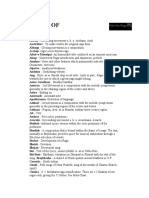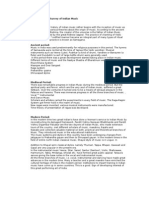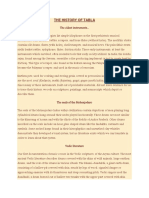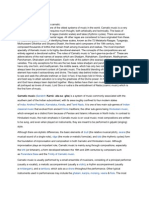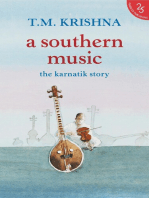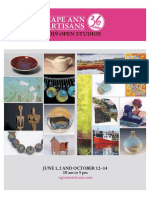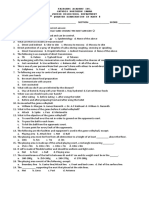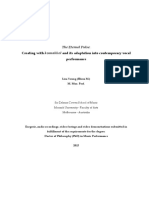Raga Music
Raga Music
Uploaded by
elanw514Copyright:
Available Formats
Raga Music
Raga Music
Uploaded by
elanw514Original Description:
Copyright
Available Formats
Share this document
Did you find this document useful?
Is this content inappropriate?
Copyright:
Available Formats
Raga Music
Raga Music
Uploaded by
elanw514Copyright:
Available Formats
Cultural History (see the Alves handout, there is a timeline - be able to match the dates
with the below, and be able to speak about them) DATES on pages 244-247) I've left off
the ones having to do with Southern music.
o 1800-1200 BCE: Migration of Aryans, what they brought with them, and the
development of early Hinduism, composition of Vedas
o 563 BCE: Birth of the Buddha
o 400 BCE - 400 CE: Composition of Hindu epics: Mahabharta and Rayamana (What
were they about, what are ways they were/are they transmitted in India)
o 5th C CE: Natyasastra: first treatise on the arts (including basis for classical
Indian musical theory - this is an important moment for a culture, to be able to
describe a theoretical system for its musical ideas)
o 1175 CE: Beginning of Persian influence, and introduction of Islam in the North
(while the South remained Hindu)...begins the division of Karnatic (South) and
Hindustani (North) Indian musical traditions
o 1520 - early 1700's CE: Golden age of Mughal courts - what was effect on
music?
o 1764 - 1948 CE: British colonial rule- what was effect on music? (purely
instrumental forms, not religious based, an urban artform...
o 1920's CE: brought a shift of patronage to public concerts, support by middle
class - effect on music?
o 1910 - 1932 CE: Standardization of Hindustani classical music (in the north)
o 1947-8 CE: Independence from British rule
o 1950 - 1980: Golden Age of filmi
What were the Vedas, why were they important culturally and musically?
Elements of Indian classical music (p. 247)
What is the texture of this music?
I might ask you to describe to me how to construct a raga...if I do, I'll give you a list of
vocab to draw from...you'd need to know how to use these correctly:
Raga ivolves sitar, table, tambura (drone). The name of the composition will contain a
Tala (example would be tintal), and the type of Raga (scale used, like Khamaj), avartas =
grouping of beats. Vadi and Samvadi
o drone
o raga
o bandish
o gharana
o taraf extra strings tuned to the drone note
o that pitch collection
o sruti - microtones
o svara - pitches
o sa
o aroh/avaroh
o pakar - motives
o chalan just wandering inbetween the notes
o vadi, samvadi
o cadence pitch (a resting note at the end of a phrase)
o gamaka - ornamentation
o rasa - moods
o ragamala paintings depicting the rasas
o tala: sam, khali, tali
o vibhag
o bol
o alap gat saval-javab jhala
Elements of raga (the melodic dimension of Indian music) p. 253,4
Instruments:
classify (chordophone, aerophone, idiophone, membranophone):
o sitar, sarod (can you distinguish between them?), sarangi, tanpura, bansuri,
harmonium, tabla
LISTENING ID:
I WILL BE DRAWING FROM THE TWO LISTENING GUIDES:
Raga Khamaj
o be able to identify where we are in the music if I play a section from alap, gat,
saval-javab, and jhala - and describe what is happening musically in each
o be able to to count chachar cycles (how many?) in the gat
Raga Yaman
o Identify sections: alap, gat-tora, jhala
o Identify the mukhra
o Identify the tihai
Laya & Tala
o Kl = time
o Its cyclical, not linear
o Laya
Maintenance as intervals between beats
tempo within the music
1. Vilanbit
2. Madyha
3. Drut
o Hindustatni laya goes slow to fast
o According to myth Shiva set in motion the universe through the
rhythmic danse
o Tala
Gat when the tala comes in
= Palm of the hand
organized rhythmic cycle
ranges from 3-108 beats
Matra = beats, Theka = bol arrangements (vocal sound
attributed to each beat), Vibhag = divisions (think bar lines),
Tali = clapped sections denoted by numbes, Khali = female
response (unclapped sections), Sum = x, where the cycle
restarts
o Avartan = single cycle/start of cycle
Rupak = 7
Teental = 16
o Amad = how you arrive at Sum.
o Pathakshar and Padhant syllables and vocalization
Akshar = syllable
Honors Goddess Saraswati, who is a river of all creation
o Kalykari subdivsions?
Jati/Chati 3, 4, 7, 9
Khandam = 5 beat pattern
Ateet: composition tentionally rsolvig to sum
Goon: 3/2 rhyhthm.
o Tihai melodic phrase within rhythmic pattern
Navarsa nine moods
o Nine rasas (moods)
Sadness, love / joy, heroism, /valor, laughter comedy, anger,
fear, disgust, peace
Kuchipudi type of dance, very theatrical and acting-out
o Ragamala painting of the mood or story. Each painting refers to a
Raga
o Alap = reveals the characteristics of the raga
o Saval-javab faster; question/answer with sarod and table;tala tintal
o Jhala becomes more viruosic, using thok jhala techniques with drone
string; finally ending in a dramatic unison rhythm
You might also like
- Praveshika Pratham Kathak NotesDocument6 pagesPraveshika Pratham Kathak Notesapi-43715790687% (15)
- Raga Chikitsa and Raga Ragini VidyaDocument31 pagesRaga Chikitsa and Raga Ragini Vidyasunni (aamil) spiritual healer100% (1)
- The Journey of the Sitar in Indian Classical Music: Origin, History, and Playing StylesFrom EverandThe Journey of the Sitar in Indian Classical Music: Origin, History, and Playing StylesRating: 5 out of 5 stars5/5 (1)
- Music Thesis PresentationDocument39 pagesMusic Thesis PresentationChunka OmarNo ratings yet
- Brief General Introduction To Indian MusicDocument4 pagesBrief General Introduction To Indian MusicSergioGhivelderNo ratings yet
- Indian Classical MusicDocument11 pagesIndian Classical Musicsarora_usNo ratings yet
- The IndianDocument10 pagesThe Indianjonalyn_yapNo ratings yet
- World Music Indian MusicDocument35 pagesWorld Music Indian Musicpauljsherman100% (2)
- The Epic Period - Circa 700 B.C.E. To 150 C.EDocument5 pagesThe Epic Period - Circa 700 B.C.E. To 150 C.EVijay SANo ratings yet
- ShrutiDocument7 pagesShrutiBeejay Sibbaluca100% (1)
- 213213213213213Document3 pages213213213213213Jock ItchNo ratings yet
- Understanding Indian Classical MusicDocument11 pagesUnderstanding Indian Classical MusicSuresh SeelamNo ratings yet
- Carnatic Sangeet The South Indian System of MusicDocument7 pagesCarnatic Sangeet The South Indian System of MusicTanukuNo ratings yet
- Indian Classical Music PDFDocument2 pagesIndian Classical Music PDFshagun1rastogiNo ratings yet
- 07 - Chapter I PDFDocument34 pages07 - Chapter I PDFBasharatNo ratings yet
- Indian Art Music TalkDocument18 pagesIndian Art Music Talkpavan_padma977927No ratings yet
- Appreciating Hindustani MusicDocument15 pagesAppreciating Hindustani MusicAnonymous fO8xe7rMyANo ratings yet
- Terms of RagaDocument12 pagesTerms of RagaDaniel RosaNo ratings yet
- Structure: 2 6 1 Ritta 2 6 2 Nrit ADocument7 pagesStructure: 2 6 1 Ritta 2 6 2 Nrit Aspandana aNo ratings yet
- Brief Historical Survey of Indian MusicDocument3 pagesBrief Historical Survey of Indian Musicapi-26894171100% (3)
- Sarathi2009-8-Origin of Indian MusicDocument8 pagesSarathi2009-8-Origin of Indian Musicsudipto917No ratings yet
- Music Lesson 1Document3 pagesMusic Lesson 1keethsNo ratings yet
- Raga RaginiDocument13 pagesRaga RaginiHeriton RochaNo ratings yet
- Indian MusicDocument5 pagesIndian MusicRon 'shpatz' Cohen0% (1)
- 22musical Forms Figuring in - 2Document25 pages22musical Forms Figuring in - 2rrohuuNo ratings yet
- TVA BOK 0013608 The Flute A StudyDocument45 pagesTVA BOK 0013608 The Flute A StudyRohaan KumarNo ratings yet
- BackgroundDocument4 pagesBackgroundapi-26168337No ratings yet
- Know Carnatic MusicDocument74 pagesKnow Carnatic MusicRajeetha DineshNo ratings yet
- MA Final English 2.odtDocument16 pagesMA Final English 2.odtSOLANKI NARENDRANo ratings yet
- Q3 G8 Music of India Lecture 2021Document101 pagesQ3 G8 Music of India Lecture 2021Albert Ian CasugaNo ratings yet
- Carnatic MusicDocument30 pagesCarnatic MusicTamiltamil Tamil100% (2)
- 08 - Chapter 2 - 2Document39 pages08 - Chapter 2 - 2Ari MVPDLNo ratings yet
- Asian Music and Philippine MusicDocument10 pagesAsian Music and Philippine MusicJass MasNo ratings yet
- Tabla HistoryDocument4 pagesTabla HistorySrikant RaoNo ratings yet
- Naina Malhotra Report PDFDocument31 pagesNaina Malhotra Report PDFprakashNo ratings yet
- Sargam On GuitarDocument11 pagesSargam On GuitarVeraaryans 22100% (10)
- Indian MusicDocument8 pagesIndian MusicManinder JakharNo ratings yet
- Music-Performing Arts Portfolio: - Shirin Pandita Class - Ix-DDocument9 pagesMusic-Performing Arts Portfolio: - Shirin Pandita Class - Ix-DshirinNo ratings yet
- Full Theory Hindustani VocalsDocument52 pagesFull Theory Hindustani VocalshetarthoNo ratings yet
- PresentationDocument15 pagesPresentationShaunak JādhavNo ratings yet
- 12 - Chapter 6 PDFDocument30 pages12 - Chapter 6 PDFAndieNo ratings yet
- Art and Culture of IndiaDocument42 pagesArt and Culture of IndiaPriya Dixit100% (3)
- Indian Classical Dances - Study Material FreeDocument3 pagesIndian Classical Dances - Study Material Freerahul_didoNo ratings yet
- Characteristics of MusicDocument5 pagesCharacteristics of MusicNikhilesh PrasadNo ratings yet
- "How Will I Map Sa Re Ga Ma ... " On Guitar?: Western's Note "C" Maps To Indian's Note "Sa"Document11 pages"How Will I Map Sa Re Ga Ma ... " On Guitar?: Western's Note "C" Maps To Indian's Note "Sa"Santosh PandeyNo ratings yet
- "How Will I Map Sa Re Ga Ma ... " On Guitar?: Western's Note "C" Maps To Indian's Note "Sa"Document11 pages"How Will I Map Sa Re Ga Ma ... " On Guitar?: Western's Note "C" Maps To Indian's Note "Sa"Santosh PandeyNo ratings yet
- Culture Revision Notes GV SimhaDocument28 pagesCulture Revision Notes GV Simhaamarsinha1987No ratings yet
- The Two Styles: HindustaniDocument5 pagesThe Two Styles: HindustaniPampannagowda V PatilNo ratings yet
- ThumriDocument5 pagesThumriAzure HereNo ratings yet
- PDF 09 Penelusuran Banjirppt - Compress PDFDocument50 pagesPDF 09 Penelusuran Banjirppt - Compress PDFalyapratamaputraNo ratings yet
- Raga and RasaDocument16 pagesRaga and RasaMatthew FryeNo ratings yet
- Introduction To Saint Thyagaraja's KritisDocument7 pagesIntroduction To Saint Thyagaraja's KritisIndrani GortiNo ratings yet
- Indian MusicDocument50 pagesIndian MusicRupali Chauhan67% (6)
- Indian Classical Music - Ravi ShankarDocument4 pagesIndian Classical Music - Ravi ShankarblaketimerNo ratings yet
- Indian MusicDocument8 pagesIndian MusicchrisjaeNo ratings yet
- Hindustani MusicDocument8 pagesHindustani MusicJaykishan PadiaNo ratings yet
- Sound Bites: The bendy path of classical music from Ancient Greece to today from your favourite ABC Classic presenter of Weekend Breakfast and bestselling author of Whole Notes & CadenceFrom EverandSound Bites: The bendy path of classical music from Ancient Greece to today from your favourite ABC Classic presenter of Weekend Breakfast and bestselling author of Whole Notes & CadenceNo ratings yet
- Caa 2019 BrochureDocument5 pagesCaa 2019 Brochureelanw514No ratings yet
- Atom Economy - Elan Wong 1. C H Oh A. 57G/74G /77G X 100 77% Yield 2. Nabr A. 80G/103G .78 X 100 78% Yield 3. H So A. 0G/98G 0 X 100 0% YieldDocument1 pageAtom Economy - Elan Wong 1. C H Oh A. 57G/74G /77G X 100 77% Yield 2. Nabr A. 80G/103G .78 X 100 78% Yield 3. H So A. 0G/98G 0 X 100 0% Yieldelanw514No ratings yet
- Bus Monitor 3:08 (630-930)Document2 pagesBus Monitor 3:08 (630-930)elanw514No ratings yet
- Contract For SSSSPPDocument5 pagesContract For SSSSPPelanw514No ratings yet
- Paycheck FormDocument1 pagePaycheck Formelanw514No ratings yet
- Carnatic MusicDocument59 pagesCarnatic MusicPradeepKumarNo ratings yet
- 3RD Quarter Exam in Mapeh 8Document3 pages3RD Quarter Exam in Mapeh 8Arnold LinaoNo ratings yet
- Music, Arts, Physical Education, and Health (Mapeh) : Quarter 3 - Module 1 (Week 1)Document19 pagesMusic, Arts, Physical Education, and Health (Mapeh) : Quarter 3 - Module 1 (Week 1)Albert Ian CasugaNo ratings yet
- Periodic Test - I (Grade - XII)Document4 pagesPeriodic Test - I (Grade - XII)Nishtha AggarwalNo ratings yet
- Exam Info Syllabus PraveshikaPoorna 2006Document49 pagesExam Info Syllabus PraveshikaPoorna 2006Raj KumarNo ratings yet
- Performing ArtsDocument15 pagesPerforming ArtsNight HowlersNo ratings yet
- Carnatic Music Composition DatabaseDocument142 pagesCarnatic Music Composition Databasesmtdrkd86% (14)
- General Guidelines Air IndiaDocument19 pagesGeneral Guidelines Air IndiaPRAKASHNo ratings yet
- Syama SastriDocument151 pagesSyama SastriAravindhan RanganathanNo ratings yet
- Bachlors of Music NotesDocument7 pagesBachlors of Music NotesVishnu PareekNo ratings yet
- Vishrad SyllabusDocument9 pagesVishrad SyllabusHarleen Pal100% (1)
- Mapeh 8Document2 pagesMapeh 8Jorelle Chrisitan AmbionNo ratings yet
- Learning Module in MAPEH-8Document7 pagesLearning Module in MAPEH-8Neema RelucioNo ratings yet
- SyllabusDocument3 pagesSyllabusIchaituNo ratings yet
- ISC Music 2026Document12 pagesISC Music 2026asNo ratings yet
- Ug Nep Even 2024Document7 pagesUg Nep Even 2024priyanshrastogi80No ratings yet
- Thalam Theory NotesDocument14 pagesThalam Theory NotesvedasriradhaNo ratings yet
- Evolution of Concept of TalaDocument14 pagesEvolution of Concept of TalaVidit DixitNo ratings yet
- Brochure Gestione 2024 New FinalDocument23 pagesBrochure Gestione 2024 New FinalmsNo ratings yet
- 873a Indian Music Carnatic 1 QPDocument2 pages873a Indian Music Carnatic 1 QPRudra SahaNo ratings yet
- Ethesis 1 PDFDocument170 pagesEthesis 1 PDFRicardo A Martinez100% (1)
- 07 - Chapter I PDFDocument34 pages07 - Chapter I PDFBasharatNo ratings yet
- World MusicDocument22 pagesWorld MusicSheshara100% (1)
- Grade 8 MUSIC Q3 - M1Document17 pagesGrade 8 MUSIC Q3 - M1Albert Ian Casuga50% (2)
- South Indian Rhythm DefinitionsDocument3 pagesSouth Indian Rhythm DefinitionsDouglas LemusNo ratings yet
- The Drumming Tradition of South IndiaDocument2 pagesThe Drumming Tradition of South IndiaManoj KuroorNo ratings yet
- Erdmanjoan2008 - The Empty Beat - Khali As A Sign of TimeDocument19 pagesErdmanjoan2008 - The Empty Beat - Khali As A Sign of TimegnaaNo ratings yet
- Music - Week 2Document4 pagesMusic - Week 2Jeanne Pauline OabelNo ratings yet
- Abhinavagupta's Contribution To Musicology - Jaideva SinghDocument10 pagesAbhinavagupta's Contribution To Musicology - Jaideva SinghIboloid BotNo ratings yet

















